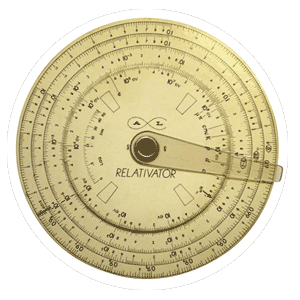Artifact: Relativator
By Elizabeth Wade
|
Enclosed Is Your Relativator!
A circular slide-rule allowed enthusiasts to perform
calculations of Einstein's special relativity in a
pre-calculator era.
Few periods in history were shaped by science as much as the 1950s. The Cold War was in full swing. The space race was finishing its first lap with Sputnik's launch. The Manhattan Project remained fresh in everyone's minds. Science, and particularly physics, was a powerful cultural force. Children were especially affected by the increased awareness, as the US government pushed for more science education. The backs of comic books famously sold products straight from the world of science fiction—X-ray glasses anyone?
One artifact from the 1950s that speaks to the culture's science obsession is the Relativator. Made by Atomic Laboratories, Inc., the Relativator is a circular slide rule designed to calculate values useful to Einstein's special theory of relativity. One Relativator is now in the hands of Brookhaven physicist and Quantum Diarist Peter Steinberg, whose mother found it among his late father's belongings.
"The whole thing was so well preserved that it felt like a time capsule," Steinberg says. It was still in the original envelope—which is stamped with the words "Enclosed is your Relativator!"—that was sent to his father. A stapled leaflet explaining the device and the special theory of relativity was also included. "It was obviously meant to appeal to budding scientists," Steinberg says. "As people didn't have pocket calculators, they could use the Relativator to perform special relativity calculations with actual numbers, instead of just doing the algebra."
|
As calculators and computers eclipsed older technologies, the Relativator slipped into oblivion. "I'd never heard of it, and judging from people's reactions, no one else had either," Steinberg says. After he wrote about the device in his Quantum Diaries blog, Steinberg received several interested responses. "There are a lot more slide rule aficionados out there than I thought," he says.
The Relativator fits perfectly into Steinberg's vision of his father's interest in science as a teenager. "My grandmother always tells a story about a teacher giving my father a chunk of uranium to bring home and keep in the closet for a science experiment. She says she looked in the closet and saw it glowing green," he laughs. "They thought differently about science then. These things weren't scary—they were neat.
"The 1950s was a time when physics probably seemed like science fiction because it was unlocking world-shaking forces," Steinberg continues. "But there's mystery around subatomic physics even today. I became a scientist because it brought me back to a childhood fascination. It is intriguing that humans can 'control' subatomic forces in a sense, by being able to calculate various aspects of their outcomes—for example with Einstein's special relativity."
From its dramatic name to the exclamation on its envelope, the Relativator represents the excitement of being able to understand an increasingly strange world—a feeling that budding scientists and PhDs alike can not afford to lose.
Click here to download the pdf version of this article.







